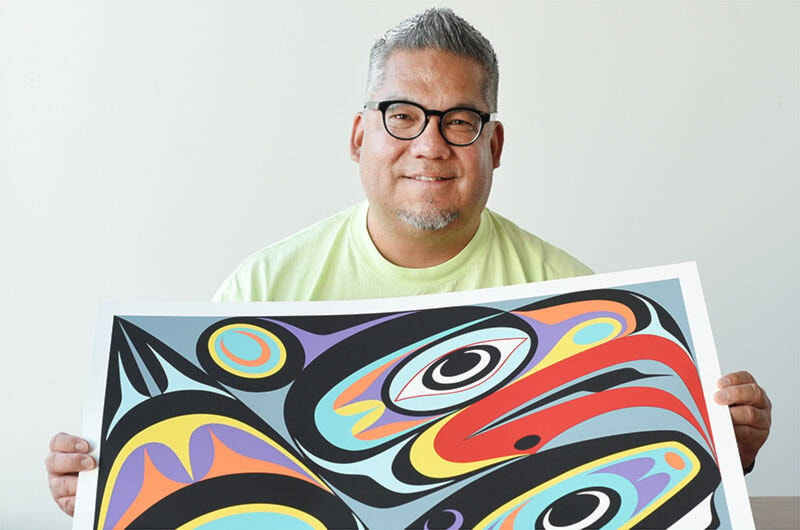- Words by Sean McIntyre Photography by Don Denton and Lia Crowe
Tucked discreetly between a “romance boutique” and an auto parts store in an unassuming strip mall near
downtown Duncan isn’t where you’d expect to find a rising star in the Canadian art world, and Maynard Johnny Jr. is totally cool with that.
Besides, the rent is cheap and it’s close to home.
Maynard has been working out of his 500-square-foot space since he moved back to the Cowichan Valley from Vancouver at the height of the COVID-19 pandemic to be closer to family and friends.
It’s easy to miss the new digs. There’s no sign out front and the only art on the walls are the marker-and-crayon-on-looseleaf works created by Maynard’s grandchildren. Maynard sits at a table, casually sketching designs on postcard-sized sheets of card stock, while his assistant Ruth, seated in the window overlooking the mall’s asphalt parking lot, calmly blocks in colours of a giant dorsal fin on a three-foot-wide canvas stretched to form a massive drum. The only other furnishings are a sofa and a kiddy table with a pair of tiny chairs, presumably used by the budding young artists who decorated Maynard’s walls.
Most of the artist’s work begins right here at the drawing table in his workshop, where he sketches out ideas that give shape to pieces inspired by Coast Salish tradition blended with a wide swathe of contemporary colours. The little sketches he’s making for a client now, for example, will eventually morph into a 36-by-48-inch canvas. While he’s drawing, thoughts about proportions, contrasting colours and the interplay of negative space come alive on paper.
Maynard can trace his interest in art back to the sketches he made when he was five or six years old. He recalls drawing portraits of his family, and then expanding into a wider range of comic-book-style illustrations. Maynard excelled at art during his middle and high school years, but loathed painting until his art teacher gave him an assignment in Grade 11, asking him to draw inspiration from his Indigenous heritage.
“I gave it a shot thinking it was going to be easy, but it was actually really hard. I stuck with it and it eventually became something I had a passion for,” he says. “I wasn’t great at academics, but I’d always been good at sports and art; I realized that I had a better chance of becoming an artist than a professional soccer player.”
It wasn’t long afterwards that Maynard found himself living the life of a young, up-and-coming artist, honing his skills and developing a unique style. There were challenges and moments of doubt, but Maynard always found the motivation and courage to keep painting. At one point, back in 1999, he was ready to call it quits when the late Robin Williams bought one of his paintings. That moment remains a turning point in his career.
“I don’t know why it was important that someone like Robin Williams liked my work, a lot of people like my work, but for some reason I felt like I was doing the right thing when he bought my piece,” Maynard says.
His decision to stick with it turned out to be a wise one.
After spending four years in Vancouver, where he says he took his career to the next level, Maynard’s recent return to Vancouver Island has coincided with a meteoric rise in his profile. In 2021, BC Ferries commissioned Maynard to create the art that adorns the company’s newly launched Salish Heron. Earlier this year, the Pacific FC soccer club asked Maynard to design a jersey for use as the team’s alternate kit (see story below).
And while the added attention hasn’t necessarily made his work any more popular—it was already in high demand—it’s made him a more recognizable presence on the West Coast art scene.
“I knew a lot of people before I moved away, but now a lot of people know me,” he says. “It’s weird because people will come up to me and say: ‘Hey, how’s it going? You’re on the BC Ferries.’ And I might not know who that was.
“I’d established myself as an artist already, so I didn’t really need the exposure, but the publicity side of it was amazing. People always knew I was as an artist, but they didn’t know what I looked like.”
Such high-exposure projects are about so much more than raising his profile, Maynard says. He hopes to encourage Canadian corporations to take on a more active role in the truth and reconciliation process. Through seeing his work on the soccer pitch or sailing through the Gulf Islands on the Salish Heron, Maynard says, he hopes non-Indigenous Canadians will reflect and make an effort to learn about the mistreatment of Canada’s Indigenous population.
Talk of truth and reconciliation needs to be about more than mere words and token actions for Maynard, whose parents and grandparents were forcibly separated from their family to attend residential schools. Reckoning with what has transpired in Indigenous communities across Canada since the arrival of European settlers requires openness, humility, curiosity and introspection. Most importantly, he adds, it begins with acknowledging the continued presence of the distinctive cultural communities that have called territories across the continent home for more than 10,000 years.
“You can’t deny the facts, and you have to look at them,” he says. “You have to acknowledge and accept that Canada was a deep, dark and messed up place for Indigenous people, and if you can’t, we’re not going to be able to move forward in any way.”
Story courtesy of , a Black Press Media publication
Like Boulevard Magazine on and follow them on



